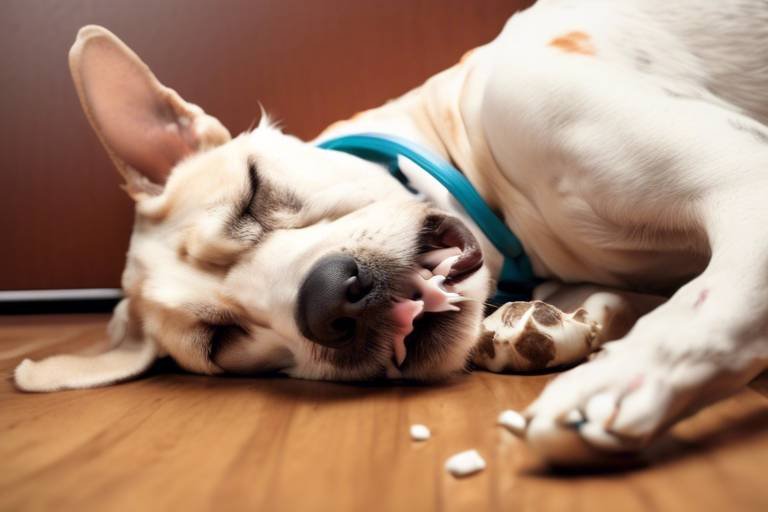What to Do If Your Pet Has a Broken Bone
Finding out that your beloved pet has a broken bone can be a heart-wrenching experience. It's a moment filled with panic, worry, and a million questions racing through your mind. What should you do first? How can you help your furry friend? The good news is that with some knowledge and quick action, you can make a significant difference in your pet's recovery. In this article, we’ll guide you through the essential steps to take when faced with this distressing situation. From recognizing the signs of a fracture to understanding what to expect from veterinary care, we’ve got you covered. Remember, your pet relies on you, and being prepared can turn a scary situation into a manageable one.
Before anything else, it's crucial to be able to recognize the signs of a broken bone in your pet. Just like humans, pets can’t always tell us when they’re in pain, so you need to be observant. Look for symptoms such as:
- Limping: If your pet is favoring one leg or struggling to walk, it could be a sign of injury.
- Swelling: Check for any swelling around the joints or bones; this could indicate a fracture.
- Unusual Behavior: If your pet is acting more withdrawn, whimpering, or showing signs of distress, they may be in pain.
Understanding these signs is the first step to getting your pet the help it needs. Don’t hesitate to act; the sooner you can seek help, the better!
Once you suspect your pet has a broken bone, it’s time to take immediate action. First aid can stabilize your pet's condition and prevent further injury. Here are some essential first aid measures:
- Keep your pet as still as possible to avoid aggravating the injury.
- Apply a cold compress to reduce swelling, but make sure it's not directly on the skin.
- Do not attempt to realign the bone; this should only be done by a professional.
Taking these steps can make a significant difference in your pet's comfort level while you prepare to visit the vet.
Calming your pet is essential to prevent further injury and to help them feel safe. Just like we might feel anxious in a stressful situation, our pets do too. Use gentle handling techniques and soothing words to reassure them. You might say something like, “It’s okay, buddy. We’re going to get you help.” This not only helps to keep them calm but also strengthens the bond between you and your pet during this tough time.
While waiting for professional help, it’s important to create a comfortable environment for your pet. Find a quiet space away from loud noises and distractions. Use soft blankets to provide cushioning and warmth. This little haven can make a world of difference in how your pet feels while they await treatment.
Understanding your pet's pain is vital for effective first aid. Observe their behavior closely. Are they panting, whimpering, or unable to settle down? These could be signs of significant discomfort. If your pet allows, gently palpate the area around the suspected fracture. If they react sharply or try to pull away, it’s a clear indication that they are in pain. Document your observations to share with your veterinarian, as this information can assist them in providing the best care.
When it’s time to head to the vet, safety during transportation is paramount. Use a sturdy pet carrier to minimize movement. If your pet is too large for a carrier, carefully wrap them in a blanket to prevent excessive movement. Ensure they are secure and comfortable, as jostling during transport can worsen their injury.
Once you arrive at the veterinary clinic, the professionals will take over. Expect them to perform a thorough examination, which may include X-rays to determine the extent of the fracture. Treatment options can vary widely depending on the severity of the injury:
| Treatment Option | Description |
|---|---|
| Splinting | A splint may be applied to stabilize the bone and allow it to heal. |
| Surgery | In severe cases, surgical intervention may be necessary to properly align the bones. |
| Medication | Pain relief and anti-inflammatory medications will likely be prescribed. |
Each case is unique, so your vet will guide you on the best course of action for your pet.
After treatment, your pet will need special care at home. This includes managing pain, administering medications, and ensuring a comfortable recovery environment. Follow your vet's instructions meticulously. Create a cozy recovery space with their favorite toys and blankets, and be sure to limit their activity as they heal. It’s important to monitor their progress and be patient; healing takes time.
Monitoring your pet for potential complications during recovery is crucial. Look out for warning signs such as:
- Increased swelling or redness at the site of the injury.
- Persistent whimpering or signs of pain despite medication.
- Loss of appetite or lethargy.
If you notice any of these signs, contact your veterinarian immediately. Quick action can prevent serious complications and ensure your pet's safe recovery.
Q: How can I tell if my pet is in pain?
A: Look for signs such as limping, whining, or changes in behavior. If they seem more withdrawn or are not eating, these could be indicators of pain.
Q: Should I try to fix the broken bone myself?
A: No, you should never attempt to realign a broken bone yourself. Always seek professional veterinary care.
Q: How long will it take for my pet to recover?
A: Recovery time varies based on the severity of the fracture and the treatment method. Your vet will provide a more accurate timeline based on your pet's specific situation.

Recognizing the Signs of a Broken Bone
Understanding the symptoms of a broken bone in pets is crucial for prompt treatment. Just like us, our furry friends can experience fractures, and recognizing the signs early can make a world of difference in their recovery. So, what should you look out for? Keep an eye on your pet for limping, which is often the first noticeable sign. If your pet is favoring one leg or seems to be walking gingerly, it could indicate a problem. Additionally, swelling around a limb is another telltale sign. If you notice any unusual bulges or puffiness, it's time to take action.
But it doesn’t stop there! Observe your pet's behavior closely. Are they acting more withdrawn than usual? Are they avoiding playtime or their favorite activities? These changes can indicate that your pet is in pain or discomfort. Sometimes, pets may even exhibit signs of distress such as whining, whimpering, or being unusually quiet. It’s essential to pay attention to these behavioral changes because they can be your best clue that something is wrong.
In some cases, you might notice your pet licking or chewing at a specific area, which could be their way of trying to soothe the pain. This behavior can often lead to further irritation or injury, so it’s important to act quickly. If your pet is showing any combination of these symptoms, don’t hesitate to seek veterinary care. Remember, the sooner you address the issue, the better the chances for a smooth recovery!
To summarize, here are the key signs to look out for:
- Limping or favoring a limb
- Swelling around the affected area
- Changes in behavior, such as withdrawal or reluctance to move
- Whining or signs of distress
- Licking or chewing at a specific area
Being vigilant about these signs can help you take the necessary steps to ensure your pet gets the care they need. Just like a parent watching over a child, your attentiveness can make all the difference in your pet's well-being.

Immediate First Aid Steps
When faced with the distressing reality of your pet having a broken bone, the first few moments are crucial. Acting quickly can make a significant difference in your pet's comfort and recovery. First and foremost, it’s essential to remain calm. Your pet can sense your anxiety, and a frantic owner can add to their stress. Take a deep breath and remember that your actions can help stabilize the situation.
Before you rush to the vet, assess the situation carefully. Look for any visible signs of injury, such as swelling, bleeding, or an unusual angle of the limb. If your pet is limping or refusing to put weight on a leg, these could be clear indicators of a fracture. In such cases, it’s vital to handle your pet gently to avoid causing further pain or injury. Use a soft blanket or towel to support your pet while you prepare for transport.
Keeping your pet calm is essential during this time. Speak to them softly and avoid sudden movements that might startle them. If your pet is small enough, you can create a makeshift stretcher using a sturdy board or a blanket to prevent them from moving around too much. For larger pets, a secure carrier is the best option. Always ensure that they are adequately secured to minimize movement during transportation, which can exacerbate the injury.
Calming your pet is crucial to their well-being. Here are a few techniques you can employ:
- Use a soothing voice to talk to your pet, reassuring them that help is on the way.
- Gently stroke their head or back, as this can have a calming effect.
- Consider using a light blanket to cover them, creating a sense of security.
While you’re preparing to leave for the veterinary clinic, it’s also essential to monitor your pet’s pain levels. Look for signs of distress, such as whimpering, panting, or excessive licking of the injury site. If your pet appears to be in severe pain, it may be tempting to give them pain relief medication, but **never** administer any drugs without veterinary guidance, as many human medications can be toxic to pets.
Once you have your pet secured for transport, consider the environment they will be in while you travel. If it’s a warm day, ensure that the car is well-ventilated. If it’s cold, provide a blanket to keep them warm. Avoid loud music or distractions in the car, as these can heighten your pet’s anxiety. Remember, your goal is to create a calm and safe environment that minimizes stress.
Understanding your pet's pain is vital for effective first aid. Pay attention to their body language. If they are withdrawing, hiding, or exhibiting aggressive behavior, these can be signs of discomfort. You can also gently palpate (touch) around the injury site to see if there’s a reaction. If your pet reacts strongly to touch, it’s likely that they are in pain. This information will be helpful for the veterinarian when you arrive.
When it's time to transport your pet, safety is paramount. If you’re using a carrier, make sure it’s sturdy and secure. Place soft bedding inside to keep your pet comfortable. If you have to use a blanket or board, ensure that your pet is well-supported and that they won’t slide off during transport. Drive carefully, avoiding sudden stops or sharp turns that could jostle your pet and worsen their injury.
In summary, the immediate steps you take when your pet has a broken bone can significantly affect their recovery. By remaining calm, providing comfort, and ensuring safe transport, you can help your pet get the care they need as quickly as possible. Remember, your veterinarian is your best resource for ensuring your pet's health and well-being.
Q: What should I do if my pet is in severe pain?
A: If your pet is in severe pain, try to keep them calm and secure. Avoid giving any medications unless directed by a veterinarian. Transport them to the vet as soon as possible.
Q: Can I splint my pet's broken bone at home?
A: It’s best to avoid splinting at home unless you are trained to do so. Improper splinting can cause more harm than good. Always seek professional veterinary care.
Q: How do I know if my pet needs immediate veterinary attention?
A: If your pet shows signs of severe pain, inability to move, swelling, or bleeding, they need immediate veterinary attention. Trust your instincts; if you’re concerned, it’s better to be safe than sorry.
Keeping Your Pet Calm
This article provides essential steps and advice for pet owners facing the distressing situation of a pet with a broken bone, including signs, first aid, and veterinary care.
Understanding the symptoms of a broken bone in pets is crucial for prompt treatment. Look for signs like limping, swelling, and unusual behavior that may indicate pain or distress.
Taking immediate action can help stabilize your pet's condition. This section outlines the first aid measures you should take before reaching a veterinary clinic to ensure your pet's safety.
When your furry friend is injured, keeping them calm is one of the most important steps you can take. Imagine how you would feel if you were in pain and scared; your pet feels the same way! The first thing to remember is that your demeanor matters. Pets are incredibly intuitive and can pick up on your emotions. If you remain calm and composed, it can help soothe their anxiety. Speak to them in a gentle, reassuring voice, and avoid sudden movements that might startle them.
Consider using soft, comforting words and gentle touches to help your pet feel secure. You might say things like, “It’s okay, buddy, we’re going to get you help,” while lightly stroking their fur. This can create a sense of safety and trust. If your pet is particularly nervous, try to create a low-stress environment. Limit noise and distractions around them, and if possible, dim the lights to make the space feel more relaxing.
Another effective technique is to use a familiar blanket or toy to provide comfort. Surrounding your pet with their favorite items can create a sense of normalcy in a chaotic situation. If your pet is small enough, you can even hold them close to you, as your warmth and heartbeat can be incredibly calming. However, be cautious and ensure that you’re not causing them any additional pain while handling them.
In some cases, you might need to use a muzzle if your pet is in significant pain and could potentially bite due to fear. It’s essential to do this carefully to avoid further stress. Always ensure that the muzzle is not too tight and that your pet can still breathe comfortably. If you’re uncertain about how to do this, consult your veterinarian for advice on safe practices.
Finally, remember that the journey to the vet can be stressful for both you and your pet. If you can, prepare a comfortable carrier or space in your vehicle ahead of time. This way, your pet will have a cozy spot to settle into during the ride. If they’re used to a specific carrier or crate, this familiarity can help ease their anxiety. By taking these steps, you’re not just helping your pet feel better; you’re also ensuring that they get the care they need as quickly and safely as possible.
Once at the vet, various treatment options are available. This section covers the typical procedures, including X-rays, splinting, and potential surgery, depending on the severity of the fracture.
After treatment, your pet will need special care at home. This section provides guidance on managing pain, administering medications, and ensuring a comfortable recovery environment.
Monitoring your pet for potential complications is crucial during recovery. Learn about warning signs that indicate your pet may need immediate veterinary attention.
- What should I do if I suspect my pet has a broken bone? If you suspect your pet has a broken bone, keep them calm and seek veterinary care immediately.
- How can I tell if my pet is in pain? Look for signs such as whimpering, reluctance to move, and changes in appetite or behavior.
- Can I give my pet pain medication? Only give medications prescribed by a veterinarian, as some human medications can be harmful to pets.
- How long does it take for a pet to recover from a broken bone? Recovery time varies based on the severity of the fracture and the pet's overall health, but it can take several weeks to months.
Creating a Comfortable Environment
This article provides essential steps and advice for pet owners facing the distressing situation of a pet with a broken bone, including signs, first aid, and veterinary care.
Understanding the symptoms of a broken bone in pets is crucial for prompt treatment. Look for signs like limping, swelling, and unusual behavior that may indicate pain or distress.
Taking immediate action can help stabilize your pet's condition. This section outlines the first aid measures you should take before reaching a veterinary clinic to ensure your pet's safety.
Calming your pet is essential to prevent further injury. Techniques such as gentle handling and soothing words can help keep your pet relaxed during this stressful time.
When your pet is injured, creating a comfortable environment is vital for their recovery. Think of it as setting up a cozy little nest where they can feel safe and secure. Start by choosing a quiet space away from the hustle and bustle of daily life. This could be a secluded corner of a room or a favorite spot on the couch. Make sure the area is free from any clutter that could pose a risk of further injury.
Next, consider the bedding. A soft, supportive bed or blanket can provide the comfort your pet needs. You want to ensure that they have enough cushioning to avoid putting pressure on their injury. If your pet is small, a pet carrier can also serve as a safe haven, just make sure it’s lined with something soft.
Temperature can also play a significant role in your pet's comfort. Ensure the room is at a suitable temperature—not too hot and not too cold. If it’s chilly, a warm blanket can make a world of difference. If your pet enjoys the warmth, you might even consider a heated pet pad, but be sure to monitor them to avoid overheating.
Lastly, keep in mind that pets often feel more secure with familiar items around them. Surround your pet with their favorite toys or a piece of your clothing. The familiar scents can provide a sense of safety and comfort during this stressful time.
Understanding your pet's pain is vital for effective first aid. This section will guide you on how to assess your pet's discomfort and respond appropriately.
When transporting your injured pet to the vet, safety is paramount. Learn the best practices for securing your pet in a carrier or vehicle to minimize movement and pain.
Once at the vet, various treatment options are available. This section covers the typical procedures, including X-rays, splinting, and potential surgery, depending on the severity of the fracture.
After treatment, your pet will need special care at home. This section provides guidance on managing pain, administering medications, and ensuring a comfortable recovery environment.
Monitoring your pet for potential complications is crucial during recovery. Learn about warning signs that indicate your pet may need immediate veterinary attention.
- What should I do if I suspect my pet has a broken bone? - It's important to keep your pet calm and seek veterinary care immediately.
- How can I tell if my pet is in pain? - Look for signs such as whimpering, reluctance to move, or changes in behavior.
- Can I give my pet pain medication? - Always consult your veterinarian before giving any medication to your pet.
- How long does it take for a pet to recover from a broken bone? - Recovery time varies depending on the severity of the fracture and the type of treatment administered.
Assessing Pain Levels
Understanding your pet's pain level is crucial when dealing with a broken bone. Animals can’t verbally express their discomfort like we do, so it’s up to us as pet owners to be vigilant and observant. Start by watching for behavioral changes; is your pet more withdrawn than usual? Are they avoiding putting weight on a specific limb? These signs can indicate that your furry friend is in pain and needs immediate attention.
One effective way to gauge your pet's pain level is to observe their body language. For instance, a pet in pain may exhibit signs such as:
- Whining or whimpering: Vocalizations can indicate distress.
- Restlessness: If your pet can't seem to settle down, it may be a sign of discomfort.
- Changes in appetite: A pet that suddenly refuses to eat may be experiencing pain.
- Protective behavior: If your pet is guarding a specific area of their body or flinches when you touch them, they might be hurting.
Additionally, consider performing a gentle examination of the affected area, if it’s safe to do so. Look for signs of swelling, bruising, or heat, which can also signify injury. Be cautious, as your pet may react negatively if you touch a painful spot. If your pet allows it, you can softly palpate around the area, but if they show signs of increased discomfort, it’s best to stop and seek veterinary help.
Another method to assess pain is to use a simple scale, similar to what human doctors might use. You can rate your pet's pain on a scale of 1 to 10, where 1 is minimal discomfort and 10 is extreme pain. This can help you communicate effectively with your veterinarian about your pet's condition. Here’s a quick reference:
| Pain Level | Description |
|---|---|
| 1 | Minimal discomfort; pet is still active. |
| 5 | Moderate pain; pet shows signs of distress. |
| 10 | Severe pain; pet is unable to move or respond. |
Lastly, keep in mind that pain assessment can vary from one pet to another. Some pets are more stoic, while others may be more expressive about their pain. Always trust your instincts as a pet owner. If you feel something is off, it’s better to err on the side of caution and consult your veterinarian. After all, your pet relies on you to be their voice, especially in times of distress.
Q: How can I tell if my pet is in pain?
A: Look for signs such as changes in behavior, vocalizations, reluctance to move, or changes in appetite. Observing their body language can also provide clues.
Q: What should I do if I suspect my pet has a broken bone?
A: Remain calm, assess the situation, and seek veterinary care immediately. In the meantime, keep your pet calm and comfortable.
Q: Can I give my pet pain medication?
A: Never give your pet human pain medication without consulting a veterinarian, as many can be toxic to pets.
Q: How long will it take for my pet to recover from a broken bone?
A: Recovery time varies based on the severity of the fracture and the treatment provided. Always follow your veterinarian's guidance for the best outcome.
Transporting Your Pet Safely
When your beloved pet is injured, especially with a broken bone, the last thing you want to do is exacerbate their pain or cause additional harm during transportation. Safety is paramount, and there are several key steps you should take to ensure that your furry friend remains as comfortable and secure as possible on the way to the veterinary clinic. First and foremost, you need to assess the situation. If your pet is in shock or experiencing severe pain, it's important to handle them gently and avoid unnecessary movement.
Using a sturdy carrier is often the best option for transporting your pet. Make sure the carrier is well-ventilated and spacious enough for your pet to lie down comfortably. If your pet is small enough, you can also consider wrapping them in a blanket to provide additional support. This can help immobilize the injured area and keep your pet feeling cozy. Remember, the goal is to minimize movement to prevent further injury. If your pet is larger, you may need to use a stretcher or even a blanket to carry them, ensuring that their body is supported and stable.
Before you start the journey, it’s wise to secure the carrier in your vehicle. Place it on a flat surface and use seatbelts or other restraints to keep it from sliding around during transit. This is crucial not only for your pet's safety but also for yours. Distracted driving can lead to accidents, so make sure your pet is secure and won’t be a distraction. If your pet is particularly anxious, consider playing some soft music in the car to help soothe them during the ride.
As you drive, keep an eye on your pet. If they seem to be in distress or their condition appears to worsen, pull over safely and assess the situation. Check for signs of shock, such as rapid breathing, pale gums, or lethargy. If you notice any of these symptoms, it may be necessary to call your veterinarian for advice on whether to continue to the clinic or seek immediate assistance.
In summary, transporting your pet safely involves careful planning and consideration. Always prioritize their comfort and safety by using appropriate carriers, securing them in your vehicle, and monitoring their condition throughout the journey. By taking these precautions, you can help ensure that your pet receives the care they need without further complications.
- What should I do if my pet is panicking during transport? - Speak to them in a calm voice and avoid sudden movements. You can also cover their carrier with a light blanket to help them feel more secure.
- Is it safe to drive with my pet in my lap? - No, it is not safe. Always use a carrier or secure your pet in the back seat to prevent distractions and ensure safety.
- How can I tell if my pet is in shock? - Look for symptoms like rapid breathing, pale gums, or a weak pulse. If you suspect shock, contact your veterinarian immediately.

Veterinary Care and Treatment Options
Once you arrive at the veterinary clinic, the first priority is to assess the situation thoroughly. The vet will likely perform a physical examination to determine the extent of the injury. This may involve checking for swelling, tenderness, and any signs of deformity. X-rays are usually the next step, as they provide a clear image of the broken bone, allowing the veterinarian to evaluate the fracture's severity and type. Understanding the nature of the break is crucial for deciding on the most appropriate treatment plan.
In many cases, fractures can be treated with non-surgical methods. This often includes the application of a splint or cast to immobilize the affected area, allowing the bone to heal naturally. Your vet will explain the process, including how long the splint or cast will need to remain in place. It's essential to follow their instructions closely to ensure proper healing. For certain types of fractures, particularly those that are more complex or involve joint areas, surgery may be necessary. Surgical options can include:
- Internal Fixation: This involves placing metal plates or screws inside the body to stabilize the bone.
- External Fixation: This method uses pins placed outside the body to hold the bone in place while it heals.
- Bone Grafting: In cases where there is significant bone loss, grafting may be required to encourage healing.
After the treatment, your veterinarian will provide you with a detailed recovery plan. This plan will typically include medications for pain management and instructions on how to care for your pet during the healing process. It’s vital to monitor your pet closely for any signs of discomfort or complications. Regular follow-up appointments may be necessary to ensure the bone is healing properly.
During recovery, your pet may need to be kept calm and confined to prevent further injury. This can be challenging, especially with active pets, but creating a peaceful environment can significantly aid in their healing. Make sure to provide a comfortable space with soft bedding and limited access to stairs or jumping areas. Additionally, maintaining a balanced diet and ensuring hydration will help your pet recover more effectively.
In summary, the veterinary care for a pet with a broken bone involves a thorough examination, possible X-rays, and a tailored treatment plan that may include either non-surgical or surgical options. As a pet owner, being informed and proactive about your pet's care can make a significant difference in their recovery journey.
Q: How can I tell if my pet's fracture is serious?
A: Look for signs such as extreme pain, inability to use the limb, visible deformities, or excessive swelling. If you notice any of these, seek veterinary care immediately.
Q: Can pets heal from broken bones without surgery?
A: Yes, many fractures can heal with non-surgical methods like splints or casts, depending on the type and severity of the fracture.
Q: How long does it take for a pet to recover from a broken bone?
A: Recovery time varies based on the fracture type and treatment method, but it typically ranges from a few weeks to several months.
Q: What should I watch for during my pet's recovery?
A: Monitor for signs of pain, swelling, or any unusual behavior. If you notice anything concerning, contact your veterinarian right away.
Post-Treatment Care at Home
Once your beloved pet has received veterinary treatment for their broken bone, the real work begins at home. This phase is crucial for your pet's recovery and requires your utmost attention and care. You might be wondering, "What can I do to help my pet heal faster?" Well, you're in luck! Here are some essential steps to ensure your furry friend is comfortable and on the road to recovery.
First and foremost, pain management is critical. Your vet may prescribe medications to alleviate your pet's discomfort. It's essential to follow the dosage instructions precisely. Overmedicating can be harmful, while underdosing might leave your pet in pain. Always keep an eye on how your pet responds to the medication. If you notice any adverse effects or if the pain seems to persist, don't hesitate to contact your veterinarian.
Next, creating a comfortable recovery environment is vital. Set up a quiet space where your pet can rest undisturbed. This area should be away from the hustle and bustle of daily life, with soft bedding and familiar toys to make them feel secure. Think of it as their personal healing sanctuary. You can also use calming aids like pheromone diffusers or soft music to help soothe their nerves.
During the recovery phase, it's crucial to monitor your pet's mobility. While it's important for them to rest, you also want to encourage gentle movement to prevent stiffness. Short, supervised bathroom breaks are a good way to balance rest and mobility. Just remember, no jumping or running! If your pet is overly active, gently remind them to take it easy. You can use a leash for walks, even in your yard, to keep them under control.
Another aspect of post-treatment care is nutrition. Feeding your pet a well-balanced diet can significantly impact their healing process. Ensure they have access to fresh water and consider incorporating vet-recommended supplements that promote bone health. If your pet has a reduced appetite, try warming their food or offering small, frequent meals to entice them to eat.
Finally, keep a close eye on any signs of complications during the recovery period. Look for symptoms such as swelling, increased pain, or changes in behavior. If your pet seems lethargic or refuses to eat, it's time to reach out to your vet. Remember, vigilance is key to ensuring your pet heals properly.
In summary, post-treatment care at home is about creating a nurturing environment that promotes healing while keeping a watchful eye on your pet's recovery journey. With your love and attention, your furry friend will be back to their playful self in no time!
- How long does it take for a pet to recover from a broken bone? Recovery time varies depending on the type and severity of the fracture, but it generally takes several weeks to a few months.
- Can I give my pet human pain medication? No, never give your pet human medications unless specifically prescribed by a veterinarian, as many can be toxic to animals.
- What signs indicate my pet may need to see the vet again? Look for severe swelling, inability to use the affected limb, or any sudden changes in behavior or appetite.
Signs of Complications to Watch For
When your furry friend is recovering from a broken bone, it’s essential to keep a watchful eye on their progress. Just like a superhero needs to be alert for any signs of danger, you too must be vigilant for potential complications that could arise during your pet's healing process. Complications can range from mild to severe, and recognizing them early can make all the difference in your pet's recovery journey.
First and foremost, monitor your pet's behavior. If they suddenly become more lethargic than usual or show signs of distress, this could be a red flag. Pay attention to changes in their appetite; if they refuse to eat or drink, this could indicate that something is wrong. Additionally, keep an eye on their mobility. If your pet seems to be in more pain than before or is unable to bear weight on the injured limb, it’s time to reach out to your veterinarian.
Another critical area to observe is the site of the injury. Look for signs of swelling, redness, or discharge around the fracture area. These symptoms could indicate an infection or improper healing. If you notice any unusual changes, such as a foul smell or an open wound, don't hesitate to contact your vet immediately. Remember, your pet's health is paramount, and timely intervention can prevent minor issues from escalating into major problems.
In some cases, you might notice that your pet is excessively licking or chewing at the bandage or splint. This behavior can lead to further injury or infection, so it’s important to redirect their attention. Consider using an Elizabethan collar (often referred to as a "cone") to prevent them from reaching the injured area. If these behaviors persist, consult your veterinarian for additional strategies to protect the injury site.
Lastly, keep a close watch for signs of fever. Elevated body temperature can indicate an underlying issue, such as an infection. A simple way to check for fever is to take your pet's temperature rectally. A normal temperature for dogs and cats typically ranges from 101 to 102.5 degrees Fahrenheit. If you find that your pet's temperature exceeds this range, it’s crucial to seek veterinary care.
In summary, being proactive about your pet’s recovery means being aware of the signs of complications. Here’s a quick recap of the key signs to watch for:
- Lethargy or unusual behavior
- Loss of appetite or refusal to drink
- Increased pain or inability to bear weight on the limb
- Swelling, redness, or discharge at the injury site
- Excessive licking or chewing at the bandage
- Fever or elevated body temperature
By staying alert and responsive to these signs, you can help ensure that your pet has a smooth and healthy recovery. Remember, when in doubt, it’s always better to consult your veterinarian for guidance.
Q: How can I tell if my pet's broken bone is healing properly?
A: Look for signs of improvement in mobility, a decrease in pain, and a return to normal behavior. Regular check-ups with your veterinarian will also help assess healing.
Q: What should I do if I notice swelling or redness at the injury site?
A: Contact your veterinarian immediately, as these could be signs of infection or complications.
Q: Is it normal for my pet to be more lethargic after a fracture?
A: Some lethargy is normal during recovery, but if it persists or worsens, consult your veterinarian to rule out complications.
Q: How can I make my pet comfortable during recovery?
A: Create a quiet, cozy space for them to rest, provide soft bedding, and limit their activity as advised by your veterinarian.
Frequently Asked Questions
- What are the common signs that my pet has a broken bone?
Common signs of a broken bone in pets include limping, swelling in the affected area, and unusual behavior such as whimpering or reluctance to move. If you notice your pet favoring a limb or showing signs of pain, it's crucial to seek veterinary assistance immediately.
- What should I do if I suspect my pet has a broken bone?
If you suspect your pet has a broken bone, the first step is to keep them calm and still. Avoid unnecessary movement to prevent further injury. Then, contact your veterinarian for advice and prepare to transport your pet safely to the clinic.
- How can I create a comfortable environment for my injured pet?
To create a comfortable environment for your injured pet, set up a quiet space with soft bedding away from noise and distractions. Ensure they have access to water and keep their favorite toys nearby to provide comfort during their recovery.
- What are the treatment options available for a broken bone?
Treatment options for a broken bone in pets can vary depending on the severity of the fracture. Common treatments include X-rays to assess the injury, splinting to stabilize the bone, and in some cases, surgery may be necessary to properly align the broken bone.
- How can I monitor my pet for signs of complications?
Keep an eye out for signs of complications such as increased swelling, persistent pain, or changes in appetite. If your pet seems lethargic or has difficulty using the injured limb, contact your veterinarian immediately for further evaluation.
- What should I do if my pet is in pain after treatment?
If your pet is in pain after treatment, follow your vet's instructions regarding medications. Ensure they are comfortable and monitor their pain levels. If the pain persists or worsens, reach out to your veterinarian for advice on how to manage their discomfort effectively.



















